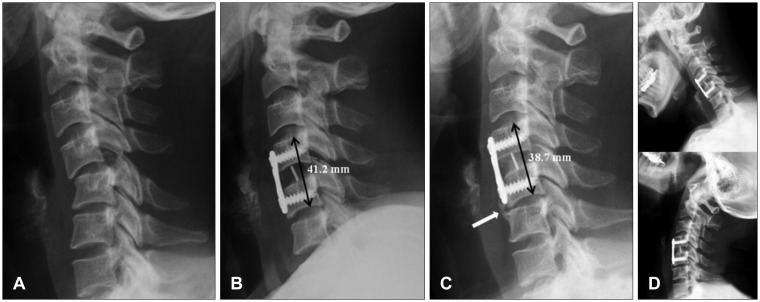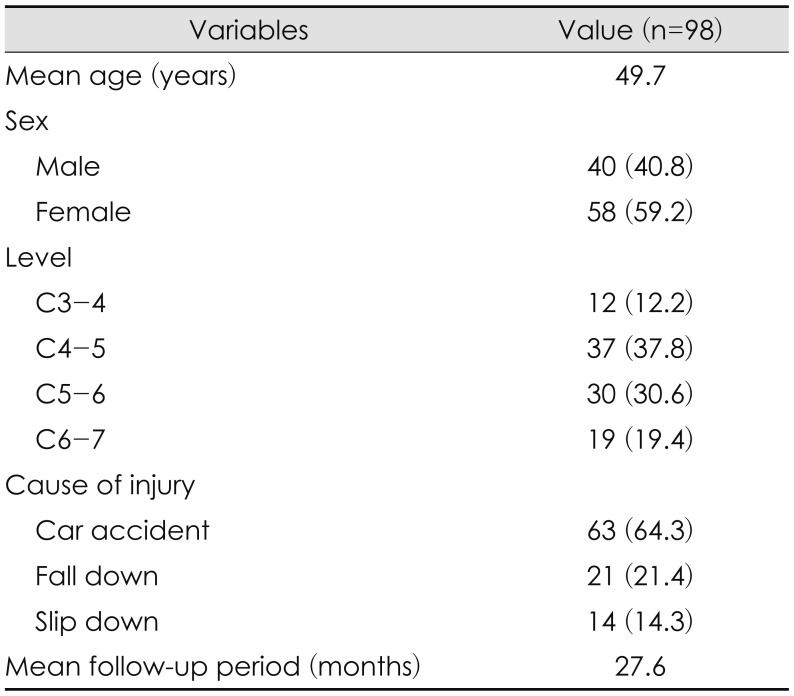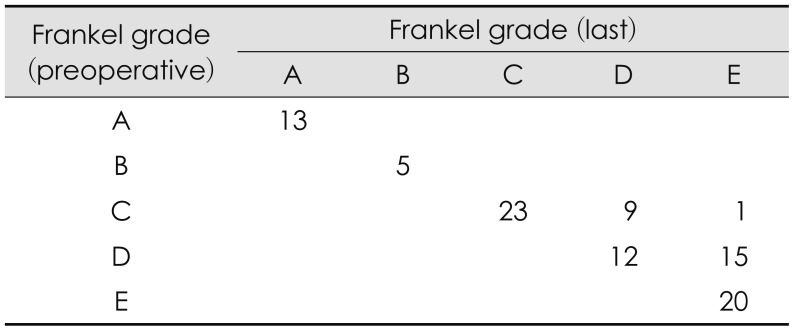1. Aaland MO, Marose K, Zhu TH. The lost to trauma patient follow-up: a system or patient problem. J Trauma Acute Care Surg. 2012; 73:1507–1511. PMID:
23147179.
2. Aebi M, Mohler J, Zäch GA, Morscher E. Indication, surgical technique, and results of 100 surgically-treated fractures and fracture-dislocations of the cervical spine. Clin Orthop Relat Res. 1986; (203):244–257.

3. Allen BL Jr, Ferguson RL, Lehmann TR, O'Brien RP. A mechanistic classification of closed, indirect fractures and dislocations of the lower cervical spine. Spine (Phila Pa 1976). 1982; 7:1–27. PMID:
7071658.

4. Barnes M, Liew S. The incidence of infection after posterior cervical spine surgery: a 10 year review. Global Spine J. 2012; 2:3–6. PMID:
24353939.

5. Bracken MB, Shepard MJ, Collins WF, Holford TR, Young W, Baskin DS, et al. A randomized, controlled trial of methylprednisolone or naloxone in the treatment of acute spinal-cord injury. Results of the Second National Acute Spinal Cord Injury Study. N Engl J Med. 1990; 322:1405–1411. PMID:
2278545.
6. Cho DY, Liau WR, Lee WY, Liu JT, Chiu CL, Sheu PC. Preliminary experience using a polyetheretherketone (PEEK) cage in the treatment of cervical disc disease. Neurosurgery. 2002; 51:1343–1349. PMID:
12445338.

7. Coe JD, Warden KE, Sutterlin CE 3rd, McAfee PC. Biomechanical evaluation of cervical spinal stabilization methods in a human cadaveric model. Spine (Phila Pa 1976). 1989; 14:1122–1131. PMID:
2588063.

8. Dhillon CS, Jakkan MS, Dwivedi R, Medagam NR, Jindal P, Ega S. Outcomes of unstable subaxial cervical spine fractures managed by posteroanterior stabilization and fusion. Asian Spine J. 2018; 12:416–422. PMID:
29879767.

9. Dimitriou R, Mataliotakis GI, Angoules AG, Kanakaris NK, Giannoudis PV. Complications following autologous bone graft harvesting from the iliac crest and using the RIA: a systematic review. Injury. 2011; 42(Suppl 2):S3–S15.

10. Fazl M, Pirouzmand F. Intraoperative reduction of locked facets in the cervical spine by use of a modified interlaminar spreader: technical note. Neurosurgery. 2001; 48:444–445. PMID:
11220393.

11. Feng G, Hong Y, Li L, Liu H, Pei F, Song Y, et al. Anterior decompression and nonstructural bone grafting and posterior fixation for cervical facet dislocation with traumatic disc herniation. Spine (Phila Pa 1976). 2012; 37:2082–2088. PMID:
22614801.

12. Frankel HL, Hancock DO, Hyslop G, Melzak J, Michaelis LS, Ungar GH, et al. The value of postural reduction in the initial management of closed injuries of the spine with paraplegia and tetraplegia. I. Paraplegia. 1969; 7:179–192. PMID:
5360915.
13. Garvey TA, Eismont FJ, Roberti LJ. Anterior decompression, structural bone grafting, and Caspar plate stabilization for unstable cervical spine fractures and/or dislocations. Spine (Phila Pa 1976). 1992; 17:S431–S435. PMID:
1440039.

14. Hadley MN, Fitzpatrick BC, Sonntag VK, Browner CM. Facet fracture-dislocation injuries of the cervical spine. Neurosurgery. 1992; 30:661–666. PMID:
1584374.

15. Han B, Tang B, Nimni ME. Combined effects of phosphatidylcholine and demineralized bone matrix on bone induction. Connect Tissue Res. 2003; 44:160–166. PMID:
14504036.

16. Harel R, Stylianou P, Knoller N. Cervical spine surgery: Approach-related complications. World Neurosurg. 2016; 94:1–5. PMID:
27373932.

17. Hattou L, Morandi X, Lefebvre J, Le Reste PJ, Riffaud L, Hénaux PL. Anterior cervical interbody fusion using polyetheretherketone cage filled with synthetic bone graft in acute cervical spine injury. Orthop Traumatol Surg Res. 2017; 103:61–66. PMID:
27720376.

18. Hilibrand AS, Carlson GD, Palumbo MA, Jones PK, Bohlman HH. Radiculopathy and myelopathy at segments adjacent to the site of a previous anterior cervical arthrodesis. J Bone Joint Surg Am. 1999; 81:519–528. PMID:
10225797.

19. Kandziora F, Pflugmacher R, Scholz M, Schnake K, Putzier M, Khodadadyan-Klostermann C, et al. Treatment of traumatic cervical spine instability with interbody fusion cages: a prospective controlled study with a 2-year follow-up. Injury. 2005; 36(Suppl 2):B27–B35. PMID:
15993115.

20. Kim SH, Lee JK, Jang JW, Park HW, Hur H. Polyetheretherketone cage with demineralized bone matrix can replace iliac crest autografts for anterior cervical discectomy and fusion in subaxial cervical spine injuries. J Korean Neurosurg Soc. 2017; 60:211–219. PMID:
28264242.

21. Malhotra AK, Martin N, Jacoby M, Tarrant J, Guilford K, Wolfe LG, et al. What are we missing: results of a 13-month active follow-up program at a level I trauma center. J Trauma. 2009; 66:1696–1702. PMID:
19509634.

22. Ordonez BJ, Benzel EC, Naderi S, Weller SJ. Cervical facet dislocation: techniques for ventral reduction and stabilization. J Neurosurg. 2000; 92:18–23. PMID:
10616053.

23. Park JH, Roh SW, Rhim SC. A single-stage posterior approach with open reduction and pedicle screw fixation in subaxial cervical facet dislocations. J Neurosurg Spine. 2015; 23:35–41. PMID:
25909272.

24. Reindl R, Ouellet J, Harvey EJ, Berry G, Arlet V. Anterior reductionfor cervical spine dislocation. Spine (Phila Pa 1976). 2006; 31:648–652. PMID:
16540868.
25. Riew KD, Rhee JM. The use of titanium mesh cages in the cervical spine. Clin Orthop Relat Res. 2002; (394):47–54. PMID:
11795751.

26. Rizzolo SJ, Piazza MR, Cotler JM, Balderston RA, Schaefer D, Flanders A. Intervertebral disc injury complicating cervical spine trauma. Spine (Phila Pa 1976). 1991; 16:S187–S189. PMID:
1862412.

27. Robertson PA, Ryan MD. Neurological deterioration after reduction of cervical subluxation. Mechanical compression by disc tissue. J Bone Joint Surg Br. 1992; 74:224–227. PMID:
1544957.

28. Shapiro S, Snyder W, Kaufman K, Abel T. Outcome of 51 cases of unilateral locked cervical facets: interspinous braided cable for lateral mass plate fusion compared with interspinous wire and facet wiring with iliac crest. J Neurosurg. 1999; 91:19–24. PMID:
10419364.

29. Silber JS, Anderson DG, Daffner SD, Brislin BT, Leland JM, Hilibrand AS, et al. Donor site morbidity after anterior iliac crest bone harvest for single-level anterior cervical discectomy and fusion. Spine (Phila Pa 1976). 2003; 28:134–139. PMID:
12544929.

30. Song KJ, Choi BW, Kim GH, Song JH. Usefulness of polyetheretherketone (PEEK) cage with plate augmentation for anterior arthrodesis in traumatic cervical spine injury. Spine J. 2010; 10:50–57. PMID:
19819189.

31. Sutterlin CE 3rd, McAfee PC, Warden KE, Rey RM Jr, Farey ID. A biomechanical evaluation of cervical spinal stabilization methods in a bovine model. Static and cyclical loading. Spine (Phila Pa 1976). 1988; 13:795–802. PMID:
3194788.
32. Theodotou CB, Ghobrial GM, Middleton AL, Wang MY, Levi AD. Anterior reduction and fusion of cervical facet dislocations. Neurosurgery. 2018; epub ahead of print. DOI:
10.1093/neuros/nyy032.

33. Woodworth RS, Molinari WJ, Brandenstein D, Gruhn W, Molinari RW. Anterior cervical discectomy and fusion with structural allograft and plates for the treatment of unstable posterior cervical spine injuries. J Neurosurg Spine. 2009; 10:93–101. PMID:
19278321.






 PDF
PDF ePub
ePub Citation
Citation Print
Print





 XML Download
XML Download